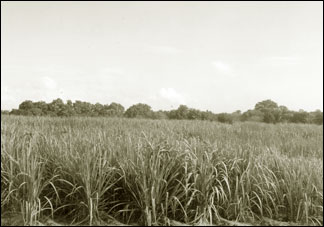Dolled up humans share commonality with refined food
by Afreeha Jawad
|

Sugar cane plantation in Uda Walawe.
|
Simplicity they say is the hallmark of greatness and if I may add to
arrive at greatness, one cannot choose to ignore excellence. One then is
necessarily linked to the other and in surfing the globe for great men
one invariably cannot miss out on the extremely simple and uncomplicated
lifestyles they have led.
It has been writer experience that the most dolled up of women and
men suffer intellectual impoverishment. Women's painted faces (I hear
even men are into it now) men's fancy for the lounge suit, the thirst
for luxurious living are then sure signs of mean and narrow thinking -
certainly no facilitator of greatness.
Quality remains intact only when originality is retained which is why
all great men chose to overlook ostentatious living.
What then has this got to do with food?
Polished rice for instance is akin to the adorned man or woman. In as
much as an adorned one loses greatness of character, any refined food
item lessens its vitamins and minerals in the process of being polished.
Having set my mind in this direction I asked Sugar Cane Research
Institute Chairman Dr. C. S. Weeraratna whether the unpolished dark
brown sugar (currently off market) was more health friendly than the
light brown sugar of today.
"Why not? In fact in its unrefined state, it bore all its nutrients
and minerals. What's more in that state it was more diabetic friendly,"
he said.
This brought to writer mind why diabetologists recommend the
unpolished rice variety to patients.
In his agenda towards developing Sri Lanka's sugar industry, Dr.
Weeraratna also includes the re-introduction of this dark brown sugar
which perhaps may not be palate friendly on the whole yet would
certainly be a favourite of those into diabetes what with the sucrose in
brown sugar being far less than in the refined one.
Currently Sri Lanka's annual sugar requirement is 550,000 metric tons
out of which we produce about 50-60 metric thousand tons. Imports stand
at 500,000 metric tons - the shortfall being 450,000 metric tons.
Local production comes off the Pelwatte and Sevanagala factories
while on the cards is the rehabilitation of Hingurana and Kantale
factories which regretfully have remained out of production for the past
decade.
Sugar production in Sevanagala and Pelwatte has benefitted around
10,000 persons bringing enhanced income to the villagers. By-products
like Bagasse (the residue following cane crushing) is used to generate
electricity in the factory. Ethanol - a fuel additive - ten percent of
which is mixed with petrol is also another by-product and strongly
recommended for motor cars is being done in Brazil. Sevanagala presently
produces twelve million litres of ethanol and is used for purposes other
than fuel.
In working towards self sufficiency in sugar the Sugar Cane Research
Institute has drawn up a comprehensive work programme. Current research
involves developing pest and disease resistant varieties.
The Woolyephid - a sugar cane friendly pest is seen currently
spreading in Moneragala and Badulla where farmers are being taught pest
control by the department.
The high cost in fertilizer - Urea being Rs. 50,000 per ton is on the
increase.
The Institute therefore is looking into the possibility of biological
Nitrogen fixation. The atmospheric nitrogen which plants are unable to
make use of could be absorbed by some organisms like bacteria and algae
- all of which are found in rooted legumes - so very useful when applied
into sugar cane cultivation. For instance glydicidia improves soil
fertility which when planted in sugar cane fields would increase
production.
The institute is also into by-products from sugar cane. For instance
better quality alcohol would help in the paint and perfume industries,
Arishta preparation and vinegar and organic compounds useful in chemical
industries.
Extension services currently help farmers in pest control, fertilizer
application and development of new varieties.
Labour increasingly is becoming a difficult factor as is the problem
with the other agricultural sectors. Urbanization being a key puller of
manpower from the agricultural sector has left this sector itself suffer
dearth of labour which then is why technological input becomes a dire
necessity. As in other countries Sri Lanka needs planned development.
Urbanization's after effects are well handled over there with
technological safeguards injected into areas of labour scarcity.
The institute is currently into small machinery to handle land
preparation, fertilizer application and harvesting. |
